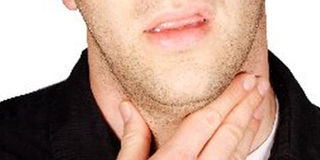Premium
Oesophagus cancer: new silent killer among Kenyans

Statistics show that Kenya is at number seven globally in incidence of this cancer. FILE
What you need to know:
- Oesophagus cancer has put Kenya on the map at number seven of the top countries with cases of the disease worldwide.
- Most of the reported cases of oesophagus cancer in Kenya are diagnosed at late stages, when little can be achieved with therapeutic intervention.
Mary Njoroge, or Mama Paul as she is popularly known by her peers, has always had an infectious laughter, the hoarseness in her voice punctuating the friendships of many years.
One of her close friends and a relative, Margaret Nyambura, says she has known Ms Njoroge to always clear her throat every time she spoke, something she never thought much about until Ms Njoroge’s visit to the doctor’s office when she was diagnosed with oesophagus cancer.
Ms Njoroge had gone to see the doctor over a swelling on her neck accompanied by pain during swallowing.
“It begun some months ago when I would feel something moving in my neck coupled with consistent heart burn, but it wasn’t something to alarm me,” she says.
Most of the reported cases of oesophagus cancer in Kenya are diagnosed at late stages, when little can be achieved with therapeutic intervention.
“It is an aggressive cancer that is hard to detect at first, with most patients having to bear the brunt of going through radiotherapy and chemotherapy without much luck,” says Catherine Nyongesa, an oncologist at the Nairobi Cancer Centre.
Oesophagus cancer has put Kenya on the map at number seven of the top countries with cases of the disease worldwide.
Statistics by the Globalcan 2008 show that the reported cases of oesophagus cancer are 13.4 per cent in a population of 100,000.
The cancer occurs in the oesophagus, which aids in swallowing of food, or the trachea. It starts with the cells lining the pipe causing problems with swallowing as it feels as if food is stuck in the throat or chest due to the oesophagus getting narrower.
Statistics also show that the highest incidence of this cancer is in Eastern Africa and Eastern Asia, with higher records in men than women.
The major cause of oesophagus cancer is tobacco smoking and alcohol use, which both account for approximately 90 per cent of the diagnosed cases.
The prevalence of oesophagus cancer is highest among African states, with Malawi, South Africa and Lesotho leading the pack.
More cases are reported by the rural population where there is high dependence on cooking with firewood in huts with poor ventilation.
Thermal injury is also said to cause oesophagus cancer as a result of drinking hot beverages.
Dr Vijay Narayanan, an oncologist says head and neck cancers are nowadays common in Africa compared to previous years.
‘‘Oesophagus cancer is becoming common, especially in Moyale and Garissa regions,’’ he said, adding that the cancer of the food pipe is linked to exposure to corrosives, poor diet and smoking.
COSTLY
A parliamentary brief says there are more cancer cases being reported in Kenya now than 10 years ago, but studies to determine the reasons for the increased prevalence and incidence are not being conducted.
It is also estimated that cancer and the other non-communicable diseases such as diabetes, cardiovascular and lung disease will cause an economic loss of output in low and middle income economies exceeding $7 trillion by 2025, a yearly loss equivalent to four per cent of annual output in a country.
Cancer treatment is currently costly in Kenya, with sessions costing up to Sh80,000 per week in private hospitals and Sh300 per session or Sh1,500 a week at the Kenya National Hospital, according to the Cancer Treatment Centre.
KNH and private hospitals, however, have an agreement to have poor patients access radiation services at a subsidised cost of Sh35,000 a week, a bill that is still too high for the poor.
Other costs incurred in cancer treatment include Sh6,000- Sh10,000 spent in preliminary investigation and drugs that cost up to Sh30,000 per course. At least six courses are required in the eight weeks of treatment.
This story first appeared in the Business Daily




